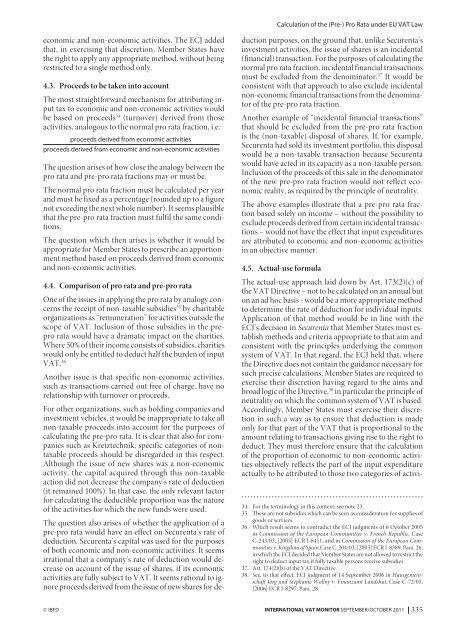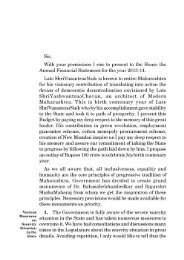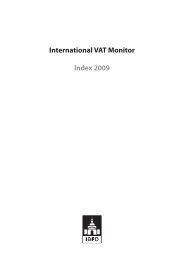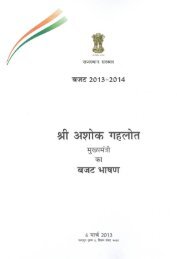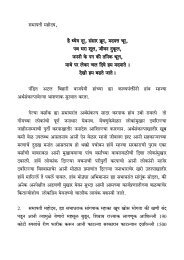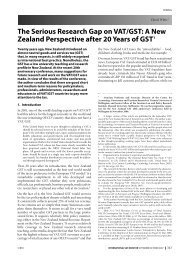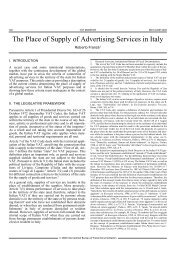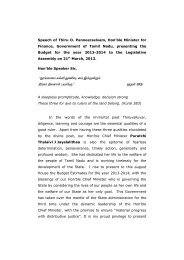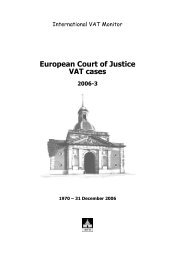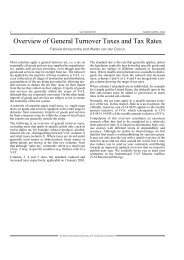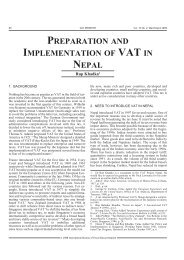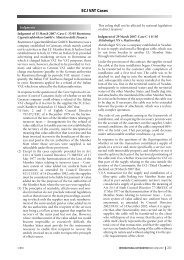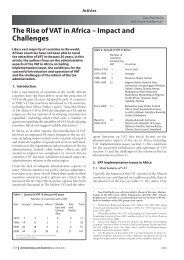Calculation of the (Pre-) Pro Rata under EU VAT Law - empcom.gov.in
Calculation of the (Pre-) Pro Rata under EU VAT Law - empcom.gov.in
Calculation of the (Pre-) Pro Rata under EU VAT Law - empcom.gov.in
Create successful ePaper yourself
Turn your PDF publications into a flip-book with our unique Google optimized e-Paper software.
economic and non-economic activities. The ECJ added<br />
that, <strong>in</strong> exercis<strong>in</strong>g that discretion, Member States have<br />
<strong>the</strong> right to apply any appropriate method, without be<strong>in</strong>g<br />
restricted to a s<strong>in</strong>gle method only.<br />
4.3. <strong>Pro</strong>ceeds to be taken <strong>in</strong>to account<br />
The most straightforward mechanism for attribut<strong>in</strong>g <strong>in</strong>put<br />
tax to economic and non-economic activities would<br />
be based on proceeds34 (turnover) derived from those<br />
activities, analogous to <strong>the</strong> normal pro rata fraction, i.e.:<br />
proceeds derived from economic activities<br />
proceeds derived from economic and non-economic activities<br />
The question arises <strong>of</strong> how close <strong>the</strong> analogy between <strong>the</strong><br />
pro rata and pre-pro rata fractions may or must be.<br />
The normal pro rata fraction must be calculated per year<br />
and must be fixed as a percentage (rounded up to a figure<br />
not exceed<strong>in</strong>g <strong>the</strong> next whole number). It seems plausible<br />
that <strong>the</strong> pre-pro rata fraction must fulfil <strong>the</strong> same conditions.<br />
The question which <strong>the</strong>n arises is whe<strong>the</strong>r it would be<br />
appropriate for Member States to prescribe an apportionment<br />
method based on proceeds derived from economic<br />
and non-economic activities.<br />
4.4. Comparison <strong>of</strong> pro rata and pre-pro rata<br />
One <strong>of</strong> <strong>the</strong> issues <strong>in</strong> apply<strong>in</strong>g <strong>the</strong> pro rata by analogy concerns<br />
<strong>the</strong> receipt <strong>of</strong> non-taxable subsidies35 by charitable<br />
organizations as “remuneration” for activities outside <strong>the</strong><br />
scope <strong>of</strong> <strong>VAT</strong>. Inclusion <strong>of</strong> those subsidies <strong>in</strong> <strong>the</strong> prepro<br />
rata would have a dramatic impact on <strong>the</strong> charities.<br />
Where 50% <strong>of</strong> <strong>the</strong>ir <strong>in</strong>come consists <strong>of</strong> subsidies, charities<br />
would only be entitled to deduct half <strong>the</strong> burden <strong>of</strong> <strong>in</strong>put<br />
<strong>VAT</strong>. 36<br />
Ano<strong>the</strong>r issue is that specific non-economic activities,<br />
such as transactions carried out free <strong>of</strong> charge, have no<br />
relationship with turnover or proceeds.<br />
For o<strong>the</strong>r organizations, such as hold<strong>in</strong>g companies and<br />
<strong>in</strong>vestment vehicles, it would be <strong>in</strong>appropriate to take all<br />
non-taxable proceeds <strong>in</strong>to account for <strong>the</strong> purposes <strong>of</strong><br />
calculat<strong>in</strong>g <strong>the</strong> pre-pro rata. It is clear that also for companies<br />
such as Kretztechnik, specific categories <strong>of</strong> nontaxable<br />
proceeds should be disregarded <strong>in</strong> this respect.<br />
Although <strong>the</strong> issue <strong>of</strong> new shares was a non-economic<br />
activity, <strong>the</strong> capital acquired through this non-taxable<br />
action did not decrease <strong>the</strong> company’s rate <strong>of</strong> deduction<br />
(it rema<strong>in</strong>ed 100%). In that case, <strong>the</strong> only relevant factor<br />
for calculat<strong>in</strong>g <strong>the</strong> deductible proportion was <strong>the</strong> nature<br />
<strong>of</strong> <strong>the</strong> activities for which <strong>the</strong> new funds were used.<br />
The question also arises <strong>of</strong> whe<strong>the</strong>r <strong>the</strong> application <strong>of</strong> a<br />
pre-pro rata would have an effect on Securenta’s rate <strong>of</strong><br />
deduction. Securenta’s capital was used for <strong>the</strong> purposes<br />
<strong>of</strong> both economic and non-economic activities. It seems<br />
irrational that a company’s rate <strong>of</strong> deduction would decrease<br />
on account <strong>of</strong> <strong>the</strong> issue <strong>of</strong> shares, if its economic<br />
activities are fully subject to <strong>VAT</strong>. It seems rational to ignore<br />
proceeds derived from <strong>the</strong> issue <strong>of</strong> new shares for de-<br />
<strong>Calculation</strong> <strong>of</strong> <strong>the</strong> (<strong>Pre</strong>-) <strong>Pro</strong> <strong>Rata</strong> <strong>under</strong> <strong>EU</strong> <strong>VAT</strong> <strong>Law</strong><br />
duction purposes, on <strong>the</strong> ground that, unlike Securenta’s<br />
<strong>in</strong>vestment activities, <strong>the</strong> issue <strong>of</strong> shares is an <strong>in</strong>cidental<br />
(f<strong>in</strong>ancial) transaction. For <strong>the</strong> purposes <strong>of</strong> calculat<strong>in</strong>g <strong>the</strong><br />
normal pro rata fraction, <strong>in</strong>cidental f<strong>in</strong>ancial transactions<br />
must be excluded from <strong>the</strong> denom<strong>in</strong>ator. 37 It would be<br />
consistent with that approach to also exclude <strong>in</strong>cidental<br />
non-economic f<strong>in</strong>ancial transactions from <strong>the</strong> denom<strong>in</strong>ator<br />
<strong>of</strong> <strong>the</strong> pre-pro rata fraction.<br />
Ano<strong>the</strong>r example <strong>of</strong> “<strong>in</strong>cidental f<strong>in</strong>ancial transactions”<br />
that should be excluded from <strong>the</strong> pre-pro rata fraction<br />
is <strong>the</strong> (non-taxable) disposal <strong>of</strong> shares. If, for example,<br />
Securenta had sold its <strong>in</strong>vestment portfolio, this disposal<br />
would be a non-taxable transaction because Securenta<br />
would have acted <strong>in</strong> its capacity as a non-taxable person.<br />
Inclusion <strong>of</strong> <strong>the</strong> proceeds <strong>of</strong> this sale <strong>in</strong> <strong>the</strong> denom<strong>in</strong>ator<br />
<strong>of</strong> <strong>the</strong> new pre-pro rata fraction would not reflect economic<br />
reality, as required by <strong>the</strong> pr<strong>in</strong>ciple <strong>of</strong> neutrality.<br />
The above examples illustrate that a pre-pro rata fraction<br />
based solely on <strong>in</strong>come – without <strong>the</strong> possibility to<br />
exclude proceeds derived from certa<strong>in</strong> <strong>in</strong>cidental transactions<br />
– would not have <strong>the</strong> effect that <strong>in</strong>put expenditures<br />
are attributed to economic and non-economic activities<br />
<strong>in</strong> an objective manner.<br />
4.5. Actual-use formula<br />
The actual-use approach laid down by Art. 173(2)(c) <strong>of</strong><br />
<strong>the</strong> <strong>VAT</strong> Directive – not to be calculated on an annual but<br />
on an ad hoc basis - would be a more appropriate method<br />
to determ<strong>in</strong>e <strong>the</strong> rate <strong>of</strong> deduction for <strong>in</strong>dividual <strong>in</strong>puts.<br />
Application <strong>of</strong> that method would be <strong>in</strong> l<strong>in</strong>e with <strong>the</strong><br />
ECJ’s decision <strong>in</strong> Securenta that Member States must establish<br />
methods and criteria appropriate to that aim and<br />
consistent with <strong>the</strong> pr<strong>in</strong>ciples <strong>under</strong>ly<strong>in</strong>g <strong>the</strong> common<br />
system <strong>of</strong> <strong>VAT</strong>. In that regard, <strong>the</strong> ECJ held that, where<br />
<strong>the</strong> Directive does not conta<strong>in</strong> <strong>the</strong> guidance necessary for<br />
such precise calculations, Member States are required to<br />
exercise <strong>the</strong>ir discretion hav<strong>in</strong>g regard to <strong>the</strong> aims and<br />
broad logic <strong>of</strong> <strong>the</strong> Directive, 38 <strong>in</strong> particular <strong>the</strong> pr<strong>in</strong>ciple <strong>of</strong><br />
neutrality on which <strong>the</strong> common system <strong>of</strong> <strong>VAT</strong> is based.<br />
Accord<strong>in</strong>gly, Member States must exercise <strong>the</strong>ir discretion<br />
<strong>in</strong> such a way as to ensure that deduction is made<br />
only for that part <strong>of</strong> <strong>the</strong> <strong>VAT</strong> that is proportional to <strong>the</strong><br />
amount relat<strong>in</strong>g to transactions giv<strong>in</strong>g rise to <strong>the</strong> right to<br />
deduct. They must <strong>the</strong>refore ensure that <strong>the</strong> calculation<br />
<strong>of</strong> <strong>the</strong> proportion <strong>of</strong> economic to non-economic activities<br />
objectively reflects <strong>the</strong> part <strong>of</strong> <strong>the</strong> <strong>in</strong>put expenditure<br />
actually to be attributed to those two categories <strong>of</strong> activi-<br />
34. For <strong>the</strong> term<strong>in</strong>ology <strong>in</strong> this context, see note 23.<br />
35. These are not subsidies which can be seen as consideration for supplies <strong>of</strong><br />
goods or services.<br />
36. Which result seems to contradict <strong>the</strong> ECJ judgments <strong>of</strong> 6 October 2005<br />
<strong>in</strong> Commission <strong>of</strong> <strong>the</strong> European Communities v. French Republic, Case<br />
C-243/03, [2005] ECR I-8411, and <strong>in</strong> Commission <strong>of</strong> <strong>the</strong> European Communities<br />
v. K<strong>in</strong>gdom <strong>of</strong> Spa<strong>in</strong>,Case C-204/03, [2005] ECR I-8389, Para. 26,<br />
<strong>in</strong> which <strong>the</strong> ECJ decided that Member States are not allowed to restrict <strong>the</strong><br />
right to deduct <strong>in</strong>put tax if fully taxable persons receive subsidies.<br />
37. Art. 174(2)(b) <strong>of</strong> <strong>the</strong> <strong>VAT</strong> Directive.<br />
38. See, to that effect, ECJ judgment <strong>of</strong> 14 September 2006 <strong>in</strong> Hausgeme<strong>in</strong>schaft<br />
Jörg und Stephanie Wollny v. F<strong>in</strong>anzamt Landshut, Case C-72/05,<br />
[2006] ECR I-8297, Para. 28.<br />
© IBFD INTERNATIONAL <strong>VAT</strong> MONITOR SEPTEMBER/OCTOBER 2011<br />
335


